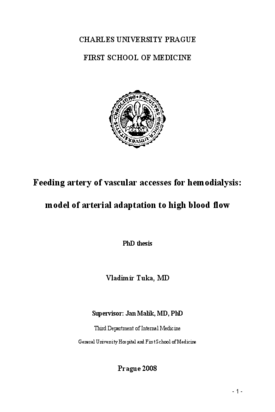Feeding artery of vascular accesses for hemodialysis: model of arterial adaptation to high blood flow
Přívodná tepna dialyzačních cévních zkratů: model arteriální adaptace na vysoký průtok
dizertační práce (OBHÁJENO)

Zobrazit/
Trvalý odkaz
http://hdl.handle.net/20.500.11956/15207Identifikátory
SIS: 112668
Kolekce
- Kvalifikační práce [4529]
Autor
Vedoucí práce
Oponent práce
Vízek, Martin
Zicha, Josef
Fakulta / součást
1. lékařská fakulta
Obor
-
Katedra / ústav / klinika
III. interní klinika - klinika endokrinologie a metabolismu 1.LF a VFN v Praze
Datum obhajoby
15. 5. 2008
Nakladatel
Univerzita Karlova, 1. lékařská fakultaJazyk
Angličtina
Známka
Prospěl/a
Background: Arteries adapt their diameter to changing haemodynamic conditions to maintain constant wall shear stress, the force generated by flowing blood on endothelial cells. The feeding artery of haemodialysis vascular accesses is a human model of arterial adaptation to chronically high blood flow and thus to high wall shear stress. The process of arterial adaptation is endothelium dependent. Endothelial dysfunction related to End-Stage Renal Failure, diabetes mellitus, dyslipidemia may impair also the dilatation of the feeding artery of vascular accesses. First the review of the literature presents in three parts different aspects of arterial adaptation: 1) arterial adaptation with focusing on the role of haemodynamic factors, 2) the influence of end-stage renal disease on arterial adaptation, 3) feeding artery of vascular accesses as a model of arterial response to chronic increase in blood flow. Methods: We examined the feeding artery of radial and brachial polytetrafluoroethylene grafts shortly after and one and two years after access creation. We used duplex ultrasonography to obtain internal diameter and blood velocity in the feeding arteries. We calculated wall shear rate as 4 x blood velocity / internal diameter and used it as approximation of wall shear stress. Results: In the first study we...
